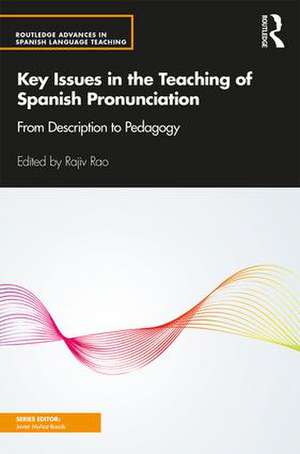Key Issues in the Teaching of Spanish Pronunciation: From Description to Pedagogy: Routledge Advances in Spanish Language Teaching
Editat de Rajiv Raoen Limba Engleză Paperback – 7 mai 2019
Key features:
- A range of topics including vowels, various classes of consonants, prosody, the use of technology, the role of orthography, the importance of both perception and production, individual learner differences, and teacher training;
- Overviews of descriptive, empirical, and acquisition-based research associated with each aspect of the Spanish sound system;
- Guidance on the difficulties that teachers face when incorporating the teaching of pronunciation into the classroom;
- Clear explanations of concepts, accompanied by an abundance of concrete examples and references;
- Multiple sample activities and lesson plans tailored to different levels and backgrounds of students;
- A bilingual glossary of terms to help the content reach the widest audience possible.
| Toate formatele și edițiile | Preț | Express |
|---|---|---|
| Paperback (1) | 439.25 lei 6-8 săpt. | |
| Taylor & Francis – 7 mai 2019 | 439.25 lei 6-8 săpt. | |
| Hardback (1) | 1008.17 lei 6-8 săpt. | |
| Taylor & Francis – 9 mai 2019 | 1008.17 lei 6-8 săpt. |
Preț: 439.25 lei
Nou
Puncte Express: 659
Preț estimativ în valută:
84.05€ • 87.75$ • 69.56£
84.05€ • 87.75$ • 69.56£
Carte tipărită la comandă
Livrare economică 04-18 aprilie
Preluare comenzi: 021 569.72.76
Specificații
ISBN-13: 9781138954618
ISBN-10: 1138954616
Pagini: 374
Ilustrații: 35 Tables, black and white; 44 Line drawings, black and white; 18 Halftones, black and white
Dimensiuni: 156 x 234 x 25 mm
Greutate: 0.53 kg
Ediția:1
Editura: Taylor & Francis
Colecția Routledge
Seria Routledge Advances in Spanish Language Teaching
Locul publicării:Oxford, United Kingdom
ISBN-10: 1138954616
Pagini: 374
Ilustrații: 35 Tables, black and white; 44 Line drawings, black and white; 18 Halftones, black and white
Dimensiuni: 156 x 234 x 25 mm
Greutate: 0.53 kg
Ediția:1
Editura: Taylor & Francis
Colecția Routledge
Seria Routledge Advances in Spanish Language Teaching
Locul publicării:Oxford, United Kingdom
Public țintă
Academic and Professional Practice & DevelopmentCuprins
Introduction
Rajiv Rao
Part I
The Sound System of Spanish
1 Description of Spanish Vowels and Guidelines for Teaching Them
Eugenio Martínez Celdrán and Wendy Elvira-García
2 Pronunciation in the L2 Spanish Classroom: The Voiceless Stops /p, t, k/
Mary L. Zampini
3 Suggestions for Teaching Spanish Voiced Stops /b, d, ɡ/ and Their Lenited Allophones [β̞, ð̞, ɣ̞]
Manuela González-Bueno
4 A Theoretical Framework in the Acquisition and Teaching of Fricatives to L2 Learners of Spanish
A. Raymond Elliott
5 Issues in the Teaching of Spanish Liquid Consonants
Benjamin Schmeiser
6 The Polymorphism of Spanish Nasal Stops
Carlos-Eduardo Piñeros
7 Incorporating Syllable Structure into the Teaching of Spanish Pronunciation
Sonia Colina
8 Improving Non-Native Pronunciation: Teaching Prosody to Learners of Spanish as a Second/Foreign Language
Carme de-la-Mota
Part II
Pedagogical Challenges and Suggestions for the Classroom
9 Spanish Pronunciation and Teaching Dialectal Variation
Germán Zárate-Sández
10 Incorporating Technology into the Teaching of Spanish Pronunciation
Gillian Lord
11 Navigating Orthographic Issues in the Teaching of Spanish Pronunciation
Yasaman Rafat and Scott James Perry
12 The Role of Perception in Learning Spanish Pronunciation
C. Elizabeth Goodin-Mayeda
13 An Analytical Approach to Teaching Spanish Pronunciation to Native Speakers of German: First Language and Age of First Exposure as Crucial Factors
Conxita Lleó and Marta Ulloa
14 Teaching Pronunciation to Spanish Heritage Speakers
Amanda Boomershine and Rebecca Ronquest
15 Spanish Pronunciation and Teacher Training: Challenges and Suggestions
Manuel Delicado Cantero, William Steed, and Alfredo Herrero de Haro
Glossary
Rajiv Rao
Part I
The Sound System of Spanish
1 Description of Spanish Vowels and Guidelines for Teaching Them
Eugenio Martínez Celdrán and Wendy Elvira-García
2 Pronunciation in the L2 Spanish Classroom: The Voiceless Stops /p, t, k/
Mary L. Zampini
3 Suggestions for Teaching Spanish Voiced Stops /b, d, ɡ/ and Their Lenited Allophones [β̞, ð̞, ɣ̞]
Manuela González-Bueno
4 A Theoretical Framework in the Acquisition and Teaching of Fricatives to L2 Learners of Spanish
A. Raymond Elliott
5 Issues in the Teaching of Spanish Liquid Consonants
Benjamin Schmeiser
6 The Polymorphism of Spanish Nasal Stops
Carlos-Eduardo Piñeros
7 Incorporating Syllable Structure into the Teaching of Spanish Pronunciation
Sonia Colina
8 Improving Non-Native Pronunciation: Teaching Prosody to Learners of Spanish as a Second/Foreign Language
Carme de-la-Mota
Part II
Pedagogical Challenges and Suggestions for the Classroom
9 Spanish Pronunciation and Teaching Dialectal Variation
Germán Zárate-Sández
10 Incorporating Technology into the Teaching of Spanish Pronunciation
Gillian Lord
11 Navigating Orthographic Issues in the Teaching of Spanish Pronunciation
Yasaman Rafat and Scott James Perry
12 The Role of Perception in Learning Spanish Pronunciation
C. Elizabeth Goodin-Mayeda
13 An Analytical Approach to Teaching Spanish Pronunciation to Native Speakers of German: First Language and Age of First Exposure as Crucial Factors
Conxita Lleó and Marta Ulloa
14 Teaching Pronunciation to Spanish Heritage Speakers
Amanda Boomershine and Rebecca Ronquest
15 Spanish Pronunciation and Teacher Training: Challenges and Suggestions
Manuel Delicado Cantero, William Steed, and Alfredo Herrero de Haro
Glossary
Notă biografică
Rajiv Rao is Associate Professor of Spanish in the Department of Spanish and Portuguese at the University of Wisconsin-Madison.
Descriere
Key Issues in the Teaching of Spanish Pronunciation: From Description to Pedagogy is a resource that encourages Spanish teachers and curriculum designers to increase their incorporation of pronunciation into the classroom. Combining theory and practical guidance, it will help language practitioners integrate the teaching of Spanish pronunciation with confidence and effectiveness. The international group of scholars across its 15 chapters is made up of individuals with well-established research records and training in best pedagogical practices.














